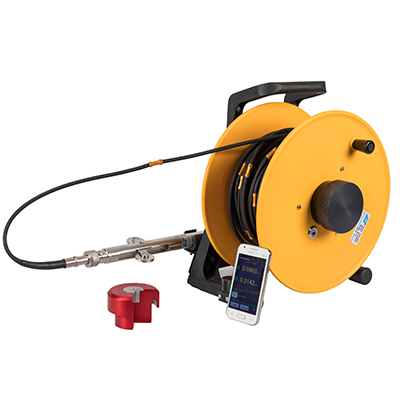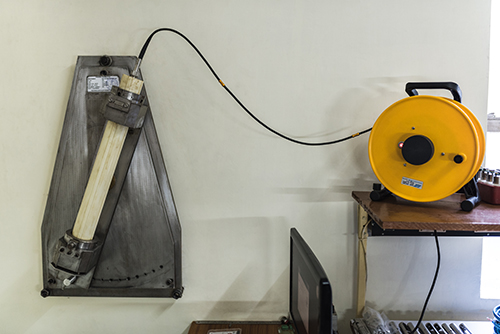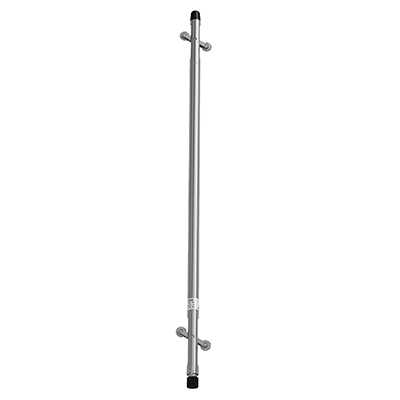An inclinometer is a geotechnical instrument employed in the measurement of the magnitude of inclination or tilt, along with its variation with time in several structures. For the same purpose, a digital inclinometer makes use of an Android OS mobile phone having a Bluetooth wireless interface as a readout device. The latest Android devices have a large 800 x 480-pixel colour display with a responsive touch screen that makes it easy to read while logging boreholes.
The data remains even if the power is turned off. The logged data can also be uploaded to a remote FTP server using a GPRS/3G cellular network. It can also be easily imported to third-party inclinometer data presentation software like GTilt or a spreadsheet program like Microsoft Excel. Since the readout unit is a mobile phone, most of the people are familiar with its operation.
In this article, we will be explaining what a digital inclinometer is, where it is used, and how it works.
What is a Digital Inclinometer?
A digital inclinometer system makes use of a traversing-type digital tilt-sensing probe that is attached to a reel unit. The reel unit is made up of a winding reel that holds the cable and a wireless Bluetooth relay unit that transmits the digital probe data to the readout unit. The Cable Reel Unit also has a rechargeable battery that supplies power to the entire system.
Encardio Rite offers two high-precision digital inclinometers; Vertical and Horizontal, which are some of the most reliable sensors produced anywhere in the world.

The digital MEMS inclinometer system is used for measuring lateral movement in applications like:
- Earth movement in the landslide zone.
- Detecting shear planes in hydraulic structures.
- Measuring stability during construction.
- Deflection of diaphragm/retaining walls and piles under load.
The Model EAN-26 digital inclinometer sensor system consists of:
- Access casing and fittings
- Tilt sensing probe
- Interconnecting cable with reel and cable holder
- Mobile phone data logger
The digital inclinometer system provides significant quantitative data on the magnitude of inclination and its variation with time. It gives complete information on the pattern of deformation and the effectiveness of construction control measures.
Read more: Inclinometer: Types, How It Works, & Uses
The digital inclinometer sensor helps in monitoring behaviour after construction and indicates potentially dangerous conditions that may adversely affect the stability of the structure, its foundation, and the surrounding area.
It also provides essential data for design improvement to promote safer and more economical design and construction. The EAN-26 digital inclinometer system is an accurate instrumentation system. Its readout (Android-based mobile device) has built-in data storage facilities and the capability of transferring stored data to a computer.
The inclinometer probe operates in a plastic grooved casing which may be “built-up” with embankment fill, inserted into boreholes, or attached externally to structures or hillsides. The inclinometer casing may be installed with telescopic couplings as construction progresses providing an opportunity for settlement measurements. It may be installed with butt joints in drill holes, abutments, or completed embankments if no significant settlement is anticipated.
If you want to know how to use a digital inclinometer system, take a look at the installation procedure shared in the article listed below.
| Also Read Digital Inclinometer System: Preparing for Installation |
How does Digital Inclinometer Work?
Inclination Measurement
 Figure 1: Inclinometer Probe Testing at Encardio Rite Facility
Figure 1: Inclinometer Probe Testing at Encardio Rite FacilityThe inclinometer probes use an accelerometer to measure the tilt angle from the true vertical line or horizontal plane concerning the earth’s surface. The accelerometer itself measures the change in acceleration due to gravity felt by it as it rotates about a horizontal axis.
The accelerometer experiences maximum acceleration when its sensitive axis is truly vertical and minimum acceleration when its sensitive axis is truly horizontal.
In a vertical inclinometer probe, the internal accelerometer is mounted such that when the inclinometer probe is truly vertical, the accelerometer-sensitive axis is aligned vertically.
In a horizontal inclinometer probe, the accelerometer sensitive axis is aligned vertically when the probe is aligned along a true horizontal plane. As the accelerometer rotates about a horizontal axis along a vertical plane, its output changes proportionally to the sine of the angle its sensitive axis makes from the true vertical.
So an inclinometer digital output is generally proportional to the sine of the angle of tilt (or inclination) rather than the tilt angle of the inclinometer probe itself. However, this sine law variation of an inclinometer probe output is more useful to us as the subsequent calculations to determine the ground profile use the sine of the tilt angle rather than the tilt angle itself.
A uniaxial vertical inclinometer probe can measure the tilt along a vertical plane passing through the probe axis. A biaxial inclinometer probe can measure the tilt independently along two vertical planes that are orthogonal to each other, with their intersection line coincident with the inclinometer probe axis.
A horizontal inclinometer probe is generally used to measure tilt along a vertical plane passing along the axis of the inclinometer. A second accelerometer is often provided to measure the tilt along a plane perpendicular to the horizontal inclinometer probe axis so that any rotation of the horizontal probe during a traverse can be detected and correction for this applied.
Digital Inclinometer cable and reel
The EAN-26 Readout unit is meant for use with the EAN-26R cable reel. The reel interfaces with digital output uniaxial or biaxial digital inclinometer probes over a long cable. The EAN-26R cable reel has a Bluetooth interface unit inside the reel and a long cable to interface with a high-accuracy digital inclinometer probe.
It is powered by a 7.2 V compact-size rechargeable battery. The power ON/OFF pushbutton is provided on the reel’s disk near the battery holder. The cable reel uses two core cables to interface with the digital inclinometer probe.
The length of the cable varies depending on the ordered option. Ferrules are crimped on cable at defined intervals to suspend the probe in a borehole. Cable reels are supplied with an ordered length of cable marked at constant distances with ferrules in either metric or imperial units of measurement.
Cable in meters has golden ferrule crimp at 0.5 meters intervals while red ferrules are crimped at 1.0 meters intervals. White ferrules are crimped at every 5.0 meters interval and are marked with the depth value. Cable in feet has golden ferrule crimp at 2.0 feet intervals while red ferrules are crimped at 4.0 feet intervals. White ferrules are crimped at every 20-foot interval and are marked with the depth value.
| Also Read: Inclinometer: Types, How It Works, & Uses |
Digital Inclinometer Probe

The Model EAN-26MV digital tilt sensing inclinometer probe is meant for use with the EAN-26R cable reel. Reel interfaces with digital output biaxial inclinometer probes (often called torpedo by other manufacturers). These types of probes are known as digital output inclinometer probes in which the output is in the form of a series of pulses.
Magnetic Digital Inclinometer probes usually use accelerometers as the basic tilt sensor. In addition, some kind of signal conditioning is also carried out to boost the signal voltage and then analogue to digital conversion to make it suitable for noise-free transmission over long cables.
The EAN-26R cable reel is designed for use with probes that require an excitation voltage of +12 to +30 V. The probe calibration is independent of the reel configuration. The Smart Tool Digital Inclinometer probe uses two MEMS sensors that are mounted orthogonally inside the probe.
They measure the tilt of the probe along a plane passing through the two-wheel arms and the other in a plane perpendicular to the first. As the measurement of inclination in two orthogonal directions is simultaneously available, the probes are known as a bi-axial probe.
The EAN-26 digital probe gives the output in digital form (in a numeric form). The output value is the distance between the two wheels multiplied by the sine of the angle of tilt in that plane. So essentially, the output of the probe is the horizontal displacement of the top wheel arm center from an axis passing through the center of the bottom wheel arm assembly along the plane of rotation or tilt.
Inclinometer probes have a significant current consumption and thus introduce a drop in excitation voltage across the connecting cable. The EAN-26 cable reel supplies an excitation voltage of +29 V. The longest cable that can be connected between the data logger and the inclinometer probe is that which will not cause the excitation voltage to drop to less than +12 V at the inclinometer probe terminals.
| Also Read Digital Inclinometer Installation in a Borehole |